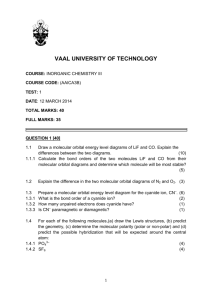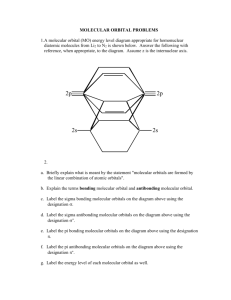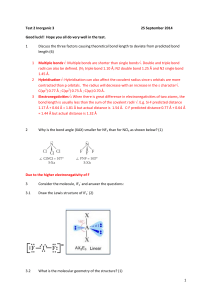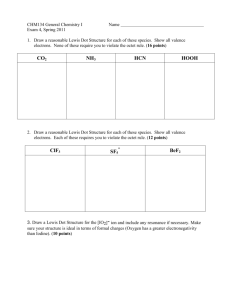Inorganic Chemistry with Doc M. Day 7. Molecular orbitals
advertisement
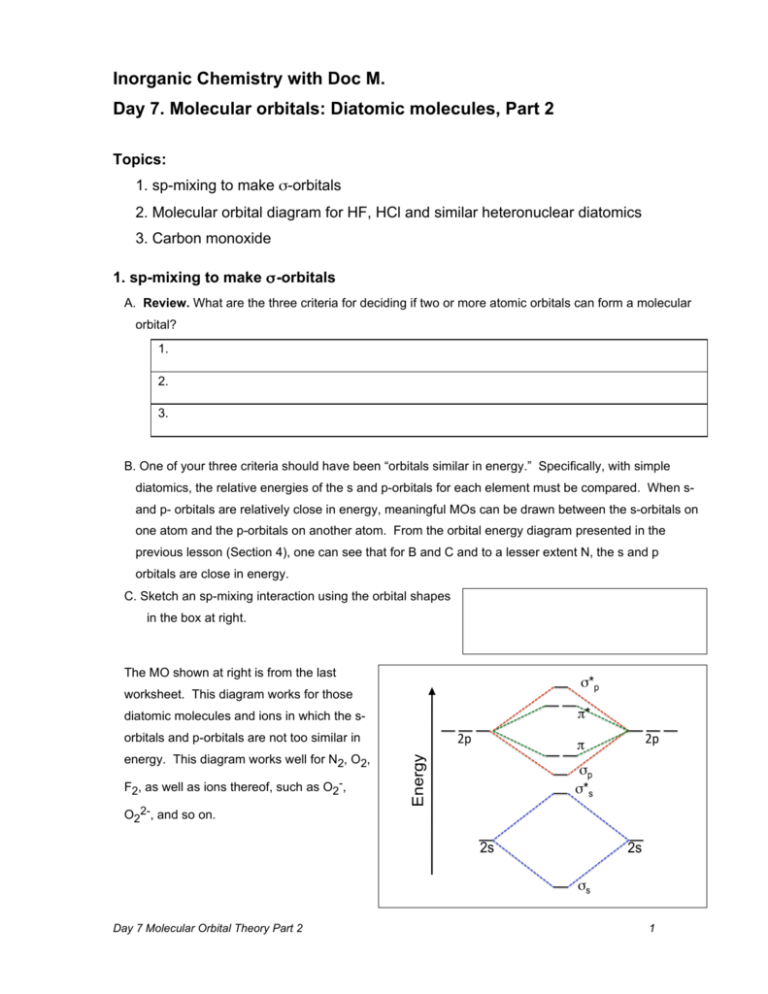
Inorganic Chemistry with Doc M. Day 7. Molecular orbitals: Diatomic molecules, Part 2 Topics: 1. sp-mixing to make σ-orbitals 2. Molecular orbital diagram for HF, HCl and similar heteronuclear diatomics 3. Carbon monoxide 1. sp-mixing to make σ-orbitals A. Review. What are the three criteria for deciding if two or more atomic orbitals can form a molecular orbital? 1. 2. 3. B. One of your three criteria should have been “orbitals similar in energy.” Specifically, with simple diatomics, the relative energies of the s and p-orbitals for each element must be compared. When sand p- orbitals are relatively close in energy, meaningful MOs can be drawn between the s-orbitals on one atom and the p-orbitals on another atom. From the orbital energy diagram presented in the previous lesson (Section 4), one can see that for B and C and to a lesser extent N, the s and p orbitals are close in energy. C. Sketch an sp-mixing interaction using the orbital shapes in the box at right. The MO shown at right is from the last worksheet. This diagram works for those diatomic molecules and ions in which the sorbitals and p-orbitals are not too similar in energy. This diagram works well for N2, O2, F2, as well as ions thereof, such as O2-, O22-, and so on. Day 7 Molecular Orbital Theory Part 2 1 When the energies of the s and p-orbitals are similar, however, modifications to the diagram are necessary due to sp-mixing. We will now redraw this MO diagram, accounting for sp-mixing. In the box at left, sketch the MO diagram, similar to the one provided on the previous page, but with some spmixing that affects the σs* MO and the σp MO, but not so much that the σp MO is now higher in energy than the π MO. In the box at right, reproduce the diagram, but this time make the sp-interaction stronger, so that the σp MO is higher in energy than the π MO. MO diagram with some s-p mixing (so that σp MO does not move above the π MO): MO diagram with significant s-p mixing (so that σp MO is now higher in energy than the π MO): Populate the above diagrams for the species B2. Determine the bond order and number of unpaired electrons in each diagram. How could one determine which one is correct? Sketch two more MO diagrams as you did above and repeat the process for the species C2. MO diagram with some s-p mixing (so that σp MO does not move above the π MO): MO diagram with significant s-p mixing (so that σp MO is now higher in energy than the π MO): Determine the bond order and number of unpaired electrons in each diagram. Day 7 Molecular Orbital Theory Part 2 2 2. Molecular orbital diagram for HF, HCl and similar heteronuclear diatomics. 1. Sketch an energy diagram for the valence atomic orbitals for H and F. From the energy chart above, one can conclude that the most important interaction is between hydrogen’s 1s and fluorine’s 2p. The interaction between hydrogen’s 1s and fluorine’s 2s can be ignored. 2. What “rule” allows us to ignore he interaction between hydrogen’s 1s and fluorine’s 2s orbital? 3. Sketch the orbitals and how they overlap near each molecular orbital energy level in the diagram above. 4. What is the bond order for HF? 5. Is the HOMO more H-like or F-like? Is the LUMO more H-like or F-like? Day 7 Molecular Orbital Theory Part 2 3 6. Orbitals that are not involved in MOs are called non-bonding orbitals. In HF, they are the 2s, the 2px and 2py, all from fluorine. They need to be sketched into the MO diagram to complete the diagram (conservation of orbitals). Complete the MO portion of the diagram above. Add all labels. 7. Sketch an energy diagram for the valence atomic orbitals for H (1s) and Cl (2s, 2px, 2py ,2pz). The chart doesn’t go as high as Cl, but Cl’s 3s orbital is lower than H’s 1s orbital in energy by about the same amount that Cl’s 3p orbitals are higher. 8. We need to consider two important interactions: the interaction between hydrogen’s 1s and chlorine’s 2s and the interaction between hydrogen’s 1s and chlorine’s 2pz. That is, we have three interested atomic orbitals. Follow the procedure discussed in lecture to prepare three molecular orbitals from three atomic orbitals. Sketch these into the diagram above. 9. Add the non-bonding orbitals to the figure and determine the bond order. Day 7 Molecular Orbital Theory Part 2 4 3. Carbon monoxide. 1. Sketch a MO energy diagram for carbon monoxide. Mixing between carbon’s s and oxygen’s porbitals is important, while mixing between oxygen’s s and carbon’s p-orbitals can be ignored. Your diagram will require you to use what you’ve learned in the HCl example (3 AOs à 3 MOs). 2. Prepare line sketches of each bonding and antibonding orbital. 3. Determine the bond order for CO. Day 7 Molecular Orbital Theory Part 2 5 Review for ACS Final Exam in Inorganic Chemistry Molecular Orbital Theory 1. The following molecular orbital is A B (a) symmetry forbidden. (b) called a d-bond. (c) is important if the energy of orbital A is similar to the energy of orbital B. (d) occurs only when atoms A and B are different. (e) occurs only when atoms A and B are the same. Answer: C Answers to Day 6 1A. B. Bonding: ΨA = (½) ½ X ΨA + (½) ½ X ΨB. Antibonding: ΨA = (½) ½ X ΨA - (½) ½ X ΨB. C and D. Day 7 Molecular Orbital Theory Part 2 6 2. Symmetry. A. σ-bonding a non-productive interaction: B. σ-bonding, and π-bonding 3. Homonuclear Diatomic Molecules A. B. Bond order. Bond order for O2 is 2 and for O2 is 1. C. F2: (σs)2 (σs*)2 (σp)2 (π)4 (π*)4 (σp*)0; O2: (σs)2 (σs*)2 (σp)2 (π)4 (π*)4 (σp*)2 The number of unpaired electrons for both F2 is 0 and for O2 is 2. MO energy diagram for the superoxide ion, O2-: (a) Bond order = 1.5; (b) O2-: (σs)2 (σs*)2 (σp)2 (π)4 (π*)4 (σp*)3; (c) paramagnetic; (d and e) molecular oxygen would have the stronger/shorter oxygen-oxygen bond. D. HOMO is π* and LUMO is σp*. Day 7 Molecular Orbital Theory Part 2 7 4. Heteroatom diatomic molecular orbitals H He B. C. Bond order for NO: 2.5; for NO+: 3.0; and for NO-: 2.0. The unpaired electron on NO is in an orbital that is more nitrogen-like. Day 7 Molecular Orbital Theory Part 2 8

